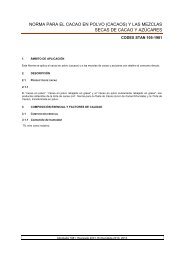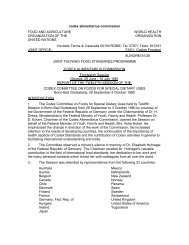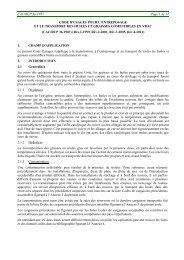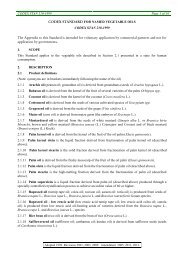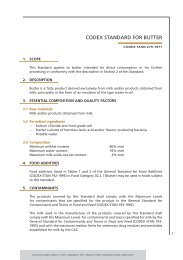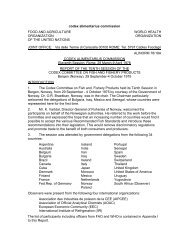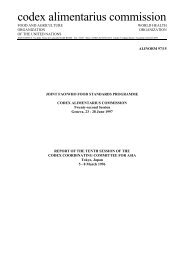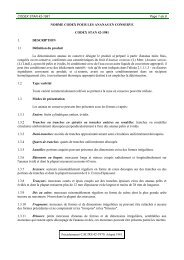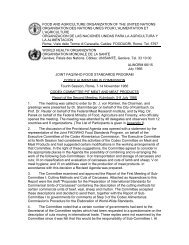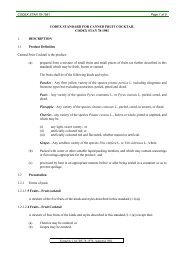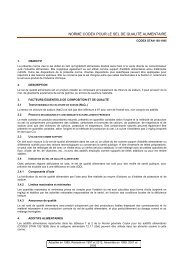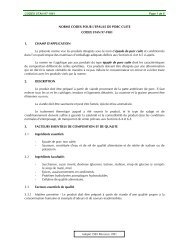REP13/FH JOINT FAO/WHO FOOD STANDARDS PROGRAMME ...
REP13/FH JOINT FAO/WHO FOOD STANDARDS PROGRAMME ...
REP13/FH JOINT FAO/WHO FOOD STANDARDS PROGRAMME ...
You also want an ePaper? Increase the reach of your titles
YUMPU automatically turns print PDFs into web optimized ePapers that Google loves.
<strong>REP13</strong>/<strong>FH</strong> Appendix V 61<br />
Goal 2: Promoting the widest and consistent application of Scientific Principles and Risk Analysis<br />
Risk analysis as it applies to food safety across the food chain is an internationally accepted discipline and<br />
will require ongoing and sustained input from Codex, its parent organizations and national governments to<br />
promote its understanding and application at the international and national levels.<br />
Goal 3: Strengthening Codex Work-Management Capabilities<br />
More expeditious and efficient work by Codex is necessary to provide members and international<br />
organizations with the standards, guidelines and recommendations that they need. In light of recent<br />
outbreaks implicating low-moisture foods, this work will be very timely.<br />
Goal 5: Promoting Maximum and Effective Participations of Members<br />
The development of this Code should generate interest and participation from all country members. We<br />
anticipate having a first face-to-face meeting following by an electronic working group using email exchanges<br />
and web meetings.<br />
6. Information on the relation between the proposal and other existing Codex documents<br />
The Code will build on the General Principles of Food Hygiene (CAC/RCP 1-1969) and will provide additional<br />
recommendations, as needed. In addition, a review of existing Codex codes of hygienic practice will be<br />
done to determine whether they adequately address the products identified in the scope in order to avoid<br />
duplication of efforts.<br />
7. Identification of any requirement for and availability of expert scientific advice<br />
We anticipate that there may be a need for scientific advice from <strong>FAO</strong>/<strong>WHO</strong> (JEMRA) on the pathogenspecific<br />
hazards associated with various food types. We will be seeking expert advice from <strong>FAO</strong>/<strong>WHO</strong> to<br />
determine which low-moisture foods represent the highest priority. The advice will then be used to better<br />
define the Scope of the document and determine if annexes should be used to include specific guidance due<br />
to the variety of food products included in the Scope.<br />
8. Identification of any need for technical input to the standard from external bodies so that this<br />
can be planned for<br />
In addition to scientific expert advice from JEMRA, technical input may be requested from the International<br />
Commission of Microbiological Specifications for Foods, especially if the working group would want to<br />
entertain the development of microbiological criteria.<br />
9. The proposed time-line for completion of the new work, including the start date, the proposed<br />
date for adoption at Step 5, and the proposed date for adoption by the Commission<br />
Proposed time lines:<br />
A five-year timeline is proposed for the completion of the Code of Hygienic Practice for Low-Moisture Foods.<br />
A proposed draft Code would be ready for initial discussion by the CC<strong>FH</strong> in 2013, with a proposed date for<br />
adoption at Step 5 in 2015 and adoption at Step 8 in 2016.



